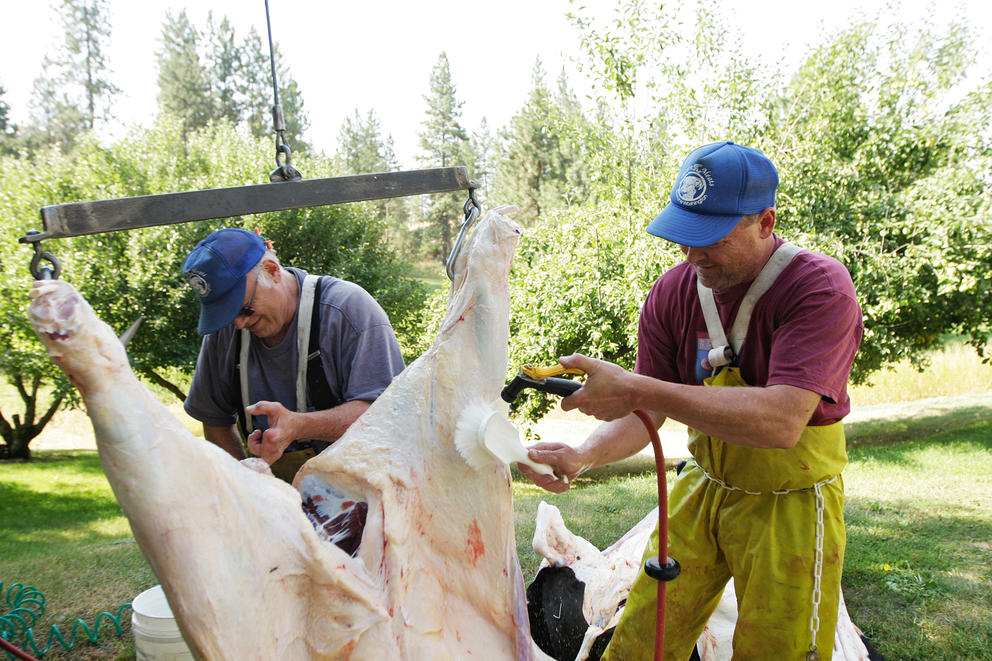With grocery stores limiting customer purchases, some Wendy’s restaurants running out of beef and the price of ground beef increasing nearly 5% from March to April, customers are flocking to ranchers like Ed Gross, who has a herd of 1,500 cattle in Eastern Washington. “Even big chain stores are looking to buy from us now,” said Gross, one of the founders of the Odessa plant.
Big meatpacking facilities have made meat cheap in the United States. But those low prices have come at a cost to workers and pushed smaller slaughterhouses out of business. Now, as people turn to small butchers for meat, the pandemic is exposing the vulnerability of this centralized system — and highlighting the importance of a diverse and resilient food economy.
The meatpacking industry has undergone major consolidation. From 1990 to 2016, the U.S. lost more than 1,800 livestock slaughterhouses, 40% of the industry. As small slaughterhouses closed, the so-called “Big Four” meatpacking companies — Tyson, Cargill, JBS and National Beef — came to dominate the industry. Today, these four companies process more than 80% of beef in the U.S.
In 2013, the Livestock Processor's Cooperative Association, a group of ranchers in Eastern Washington, tried to break the grip of industry consolidation by opening a slaughterhouse in Odessa. The plant, backed by community development agencies, would allow ranchers to tap into consumer demand for local beef without transporting cattle long distances for slaughtering or using large meatpackers.
But the cooperative struggled with inconsistent sales and hiring and retaining employees in a small town, Gross said. Now, however, with the pandemic driving demand and closing the price gap between local and industrial beef, the Odessa facility is preparing to reopen in June.
Jeff Wilke, a butcher on the outskirts of Spokane who works directly with animal owners, is also seeing unprecedented consumer interest — so much so that he’s booked up for the rest of the year. “My phone’s been ringing off the hook,” Wilke said.
Wilke’s business, Quadra K Meats, serves people who are raising their own animals and ranchers who sell directly to consumers. Wilke slaughters animals where they were raised, something he’s done since he was a kid, helping his dad in the 1970s. “Animals don’t get poked and prodded and loaded onto semis,” he said.
But that process isn’t nearly as efficient as industrial operations: The assembly lines at large meatpacking facilities can process hundreds of cattle an hour, while Wilke slaughters and processes about eight animals a week. That means meat processed by small slaughterhouses typically costs more: A locally raised and slaughtered cut of top sirloin steak at the Main Market Co-Op in Spokane costs more than $14 a pound, while a top sirloin at Walmart in Spokane costs less than half that.
Slaughterhouses like Wilke’s also confront a two-tiered system of slaughterhouse certification. Most large facilities — and some smaller ones, including the Odessa plant — are inspected by U.S. Department of Agriculture or state inspectors and permitted to sell individual cuts to stores and restaurants. Businesses like Wilke’s, however, don’t have inspectors on site and can process only animals that were purchased directly from individual ranchers.
That lack of access to venues like farmers markets makes it harder for small slaughterhouses to stay in business. In response, federal lawmakers have introduced a bipartisan bill several times in recent years. The PRIME Act would make it easier for butchers who aren’t USDA-inspected to reach customers by allowing them to sell meat to restaurants and other retail outlets.
Without such reforms, the current bump in business for small processors may not last. Right now, it’s time to “make hay while the sun shines,” said Rebecca Thistlethwaite, an agricultural extension agent at Oregon State University and the director of the Niche Meat Processor Assistance Network. But with the potential for a prolonged economic slump following the pandemic, she expects that most people will soon return to cheaper meat processed at large facilities, as happened during the Great Recession.
That would further the long-term decline of small slaughterhouses and ranching operations, leaving the meat industry even more consolidated and vulnerable to future disasters. The COVID-19 pandemic has exposed the risk of relying on just a handful of companies and factories to keep grocery stores full. A diverse system composed of businesses from large to small is key to making the food supply resilient, Thistlethwaite said. “People are realizing that now,” she said. “Hopefully, we can continue to support small producers going forward.”
This story was first published on High Country News on May 20, 2020.



